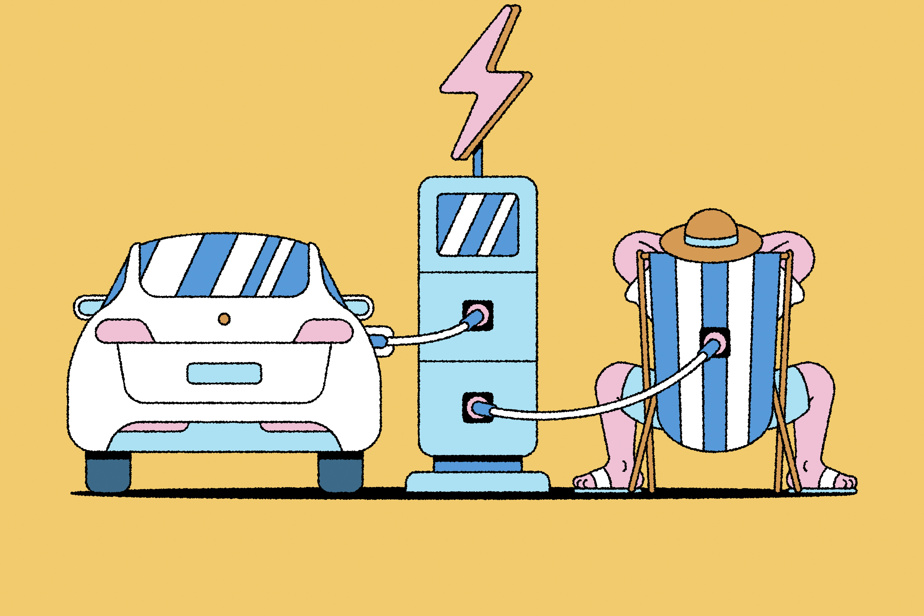Traveling is a major cause of hesitation for potential electric vehicle buyers, according to a survey. Washington Post–University of Maryland, drivers concerned about range, scarcity of charging stations.
“Travel is a big factor in the decision; people really don’t want to break down in the middle of nowhere,” says Albert Gore, director of the Zero Emission Transportation Association, a group that promotes electric vehicles. “And there are a lot more charging stations than people realize.”
Taking a road trip in an electric car is a lot easier than you think, Gore says, but he offers five tips to make the trip go smoothly.
Plan your route based on charging
Most recent electric vehicles have a navigation system that locates charging stations near you. But for a stress-free trip, it’s best to plan your stops.

PHOTO MARTIN CHAMBERLAND, LA PRESSE ARCHIVES
A charging station at the Parc des Îles-de-Boucherville. You can combine a hike with a recharge or take a “recharge-picnic” break that also allows the children to stretch their legs.
Charging infrastructure is growing at a good pace, but the number of electric vehicles on the road is growing even faster. In short, there is more competition than ever for charging, and you won’t always be able to plug in at the first station you come across.
Many apps locate and count charging stations – free or not – on your route as you approach. Try PlugShare, ChargePoint, EVgo Or Google Maps.
Gore says it’s best to give yourself some wiggle room and have a contingency plan: a Plan A that you can reach without any problems, and a Plan B further down the road, just in case.
Kill two birds with one stone
By planning, charging stops can coincide with meals, bathroom breaks or scenic stops while the battery recharges.
Mr. Gore is a regular on motorways, where many service areas have fast charging stations that can recharge a battery to three-quarters of full in less than half an hour, he says. “I go in for a bite to eat, go to the bathroom, have a coffee and when I get back to my car 20 minutes later, I’m ready to go again.”

INFOGRAPHIC THE PRESS
There are charging stations in SEPAQ parks. There are also some in some national parks in Canada. In the United States, there are 140 stations in federal parks.
But for this, you have to choose a place where there are fast direct current terminals, not level 1 or 2 chargers, which are much slower.
Charging stations are located in national park parking lots and along hiking trails. You can combine a hike with a recharge or take a “recharge-picnic” break that also gives the kids a chance to stretch their legs.
Choose hotels equipped with charging stations
If you are within 300 or 400 km of where you will spend the night, you do not need to stop en route if your hotel has charging stations. The application PlugShare and booking sites (like Expedia) point out hotels that have chargers. You plug in the car and the next morning the battery is recharged.

PHOTO PHILIP CHEUNG, THE NEW YORK TIMES
If you are within 300 or 400 km of where you will spend the night, you do not need to stop en route if your hotel has charging stations.
“It’s the best way,” Gore said. “I drive all the way, park, plug in the car, and the next day the battery is fully charged.”
Check the weather
Temperature has a big impact on range. In cold weather, batteries lose efficiency and require heating, which at -7°C can cut 40% of normal range, according to the American Automobile Association. Heat also affects range, but to a lesser extent, according to Kelley Blue Book. Extreme cold and heat also slow down charging.
Check the weather forecast before you leave. If it’s hot or cold, you’ll need to precondition the battery before charging, a process that warms or cools it to the ideal temperature for a fast, long-lasting charge. Depending on your car, this is done manually or automatically.
Avoid Heavy Foot Syndrome
Accelerating electric cars is fun, but you can get a lot of mileage out of your range by driving efficiently. You don’t have to drastically change your driving, Gore says. Just use cruise control to maintain a constant speed, maximize regenerative braking or put your car in “eco mode,” which saves battery life by limiting acceleration and optimizing air conditioning.
“If you’re not the type to drag race the guy next to you when the light turns green, you won’t even notice the difference in eco mode,” Gore says.
This article was published in the Washington Post.
Read the original version (in English; subscription required).
